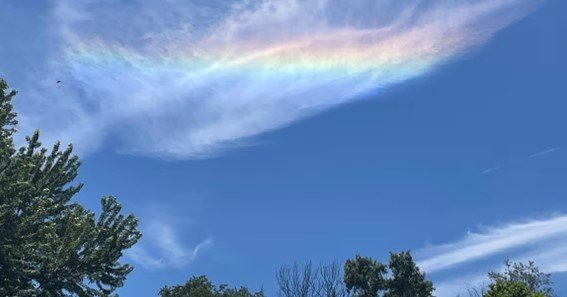Rainbow clouds, also known as iridescent clouds, are a breathtaking phenomenon where clouds appear to be painted with the colors of a rainbow. These clouds occur when sunlight interacts with tiny water droplets or ice crystals in the atmosphere, causing the light to be diffracted, or spread out, into its constituent colors. The result is a vibrant display of pastel hues—pinks, greens, purples, and blues—often seen in high-altitude clouds like cirrus or altostratus.
How To Do Rainbow Clouds Form?
Rainbow clouds form through a process called cloud iridescence. This phenomenon occurs when sunlight passes through water droplets or ice crystals that are uniformly small. These droplets and crystals scatter the light, much like a prism, and the light waves interfere with each other, creating a spectrum of colors. The colors are often more pastel and spread out than those in a typical rainbow, and they appear in patches rather than a full arc.
The conditions required for rainbow clouds include:
- High Altitude: These clouds often form in the upper atmosphere, where the air is cold and the water droplets or ice crystals are small enough to create diffraction.
- Uniform Droplet Size: The water droplets or ice crystals must be of a consistent size to create colorful diffraction.
- Right Angle of Sunlight: The sun must be positioned at a specific angle relative to the clouds for the colors to appear vividly.
One of the most dramatic examples of rainbow clouds is seen in nacreous clouds, also known as polar stratospheric clouds. These form in extremely cold temperatures, typically over polar regions, and are illuminated by sunlight from below the horizon, producing vivid, shimmering colors.
The Spectacle of Nacreous Clouds
Nacreous clouds, often referred to as “mother of pearl” clouds, are a particularly stunning example of rainbow clouds. They form in the stratosphere at altitudes of 15 to 25 kilometers and only under very cold conditions, typically below -78 degrees Celsius. The small ice particles in these clouds scatter sunlight, which creates an array of colors similar to the iridescence seen on a soap bubble. These clouds are rare and primarily visible during winter in polar regions.

Conclusion
Rainbow clouds are a beautiful reminder of the intricate and colorful displays nature can create. Whether seen in the delicate hues of iridescent clouds or the vivid colors of nacreous clouds, these phenomena are a testament to the stunning optical effects that occur in our atmosphere.
FAQ
What are rainbow clouds?
Rainbow clouds, or iridescent clouds, are clouds that display a range of colors due to the diffraction of sunlight through small water droplets or ice crystals.
How do rainbow clouds form?
They form when sunlight interacts with uniformly sized water droplets or ice crystals in the clouds, causing the light to spread out into a spectrum of colors.
Where can you see rainbow clouds?
Rainbow clouds can appear anywhere, but they are most commonly observed in high-altitude clouds like cirrus. Nacreous clouds, a type of rainbow cloud, are often seen in polar regions.
What conditions are needed for rainbow clouds to form?
The key conditions include high altitude, uniformly small water droplets or ice crystals, and the correct angle of sunlight.
Why are nacreous clouds associated with rainbow colors?
Nacreous clouds form at high altitudes and very cold temperatures, where they can scatter sunlight into vivid, rainbow-like colors, especially during polar winters.










